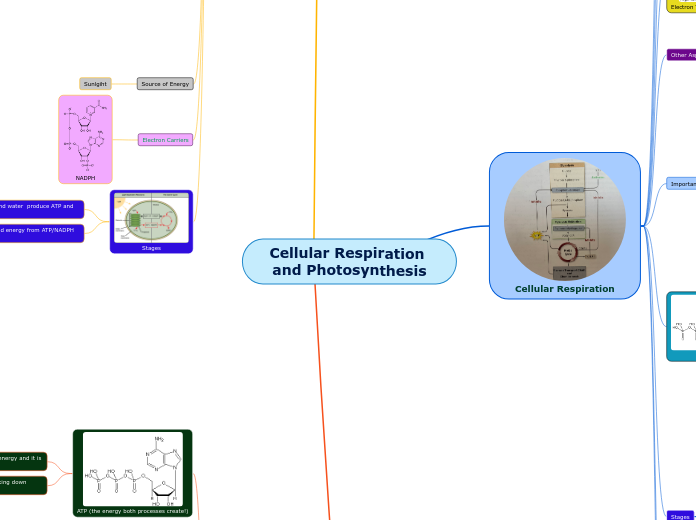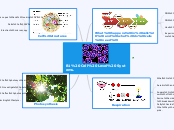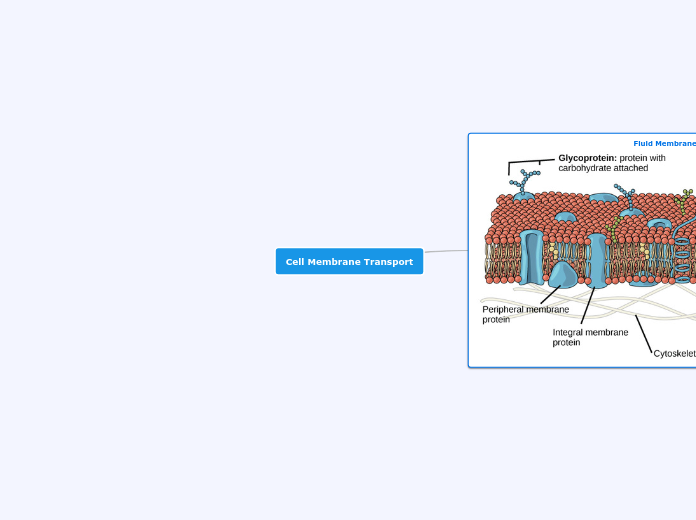Cellular Respiration and Photosynthesis
Connections
Complications
In cellular respiration, if the body does not produce ATP properly, the body will not function
Basic bodily functions will become a challenge, exhaustion will become common and death is possible
In photosynthesis if the weather is too hot, photorespiration occurs
This is a problem because the production of carbohydrates decreases
Can also be decreased using CAM plants which store water and allow for proper functioning
This is decreased using C4 photosynthesis (using C4 plants: less photo respiration and more sugar production)
Ways to make ATP
In Cellular Respiration:
Oxidative Phosphorylation: indirectly forms ATP by using a number of redox reactions
Substrate level phosphorylation: ATP is formed directly in the enzyme catalyzed reaction and a phosphate group is removed and combined with ADP to make ATP
In Photosynthesis:
Absorbed light and energy is used to drive electrons from water to generate NADPH/drive protons across a membrane - these protons go through ATP synthase and make ATP
Reaction Types
Both are considered metabolic reactions/processes
CR is a catabolic reaction which breaks down molecules to make them even smaller
PS is an anabolic reaction which builds complex molecules from small molecules
Vital for Survival
Both CR and PS produce energy and living things must do at least one of them for survival
The processes
ETC
In cellular respiration: the Krebs cycle breaks down glucose
hydrogen carriers (NADH and FADH2) release electrons for the ETC
Electrons from the ETC are taken up by
In photosynthesis: water is broken down into oxygen for electrons
Electrons from the transport chain are moved using electron molecules/carriers
Calvin cycle is used to make glucose
Relationship
They are interdependent to one another to complete their own functions
One cannot occur without the other
Both processes occur in a mututally benficial releationship
Both of these processes occur in different stages
Cellular Respiration: glycolysis, pyruvate oxidation, krebs cycle and etc/chemiosmosis
Photosynthesis: light reactions and the calvin cycle (light dependant and light independent)
Substances
Each process has similar substances involved but at different parts
The products and reactants are flipped (Products of PS are reactants of CR and vice versa) - but energy type varies (sun/ATP)
Reaction Coupling
The glucose and O2 created in photosynthesis is used during cellular respiration to make CO2 and water
This shows that these reactions are coupled as they have common substances
Redox Reactions
In cellular respiration, electrons transfer from glucose molecules to oxygen
In photosynthesis, electrons travel from water to carbon dioxide
Each process can occur in the light but cellular respiration does not require it
Water
Cellular respiration produces water
Photosynthesis uses water
Where?
Although each process is in different organelles, each takes place inside cells
CR is in the cytoplasm and mitochondria
PS is within the chloroplast
When?
Each of these processes is continuously happening for organisms to survive
Plants
Photosynthesis and cellular respiration can both occur in plants but photosynthesis is not possible in animals
CO2
In cellular respiration, carbon dioxide is released into the atmosphere
In photosynthesis, carbon dioxide is removed from the atmosphere
both use this process similarly
Uses the energy in a hydrogen ion gradient to make ATP
Photosynthesis uses light energy to release ATP.
In cellular respiration food is converted into ATP
ATP (the energy both processes create!)
In cellular respiration: ATP is produced by breaking down organic molecules themselves
In photosynthesis: ATP is produced using light energy and it is used to produce organic molecules
Photosynthesis
2. Calvin Cycle: Carbon dioxide and energy from ATP/NADPH produce glucose
1. Light Reactions: Light energy and water produce ATP and NADPH
Electron Carriers
NADPH
Source of Energy
Sunlgiht
Light
Light is not absorbed by individual pigment molecules, it is absorbed by photosystems
Photosystems in photosynthesis
PSII (P680): Chlorophyll A absorbs wavelength of 680nm
PSI (P700): Chlorophyll A absorbs wavelength of 700nm
They contain
Reaction Centre: absorbs light energy and releases excited electrons to primary electron acceptors to start the light reactions
Antenna complex: chlorophyll molecules which collect/channel energy and allows energy ti go to reaction centre
Made of chlorophyll, accessory pigments and proteins
Located in thylakoid membranes
Pigment molecules are used to absorb visible light and appear as the colour of their light wavelength
The action spectrum shows effectiveness of wavelengths promoting photosynthesis
The absorbance spectrum shows the amount of light different wavelengths can absorb
Photons are the energy that travels in waves
Each wavelength is associated with a different color on the electromagnetic spectrum
Necessary for photosynthesis to occur
Other aspects
Anabolic: builds molecules that are needed
Two sets of reactions make up photosynthesis
Light-independent reaction
Energy of ATP and reducing power of NADPH are used to make an organic molecule which is high in energy
Light-dependent reaction
Light energy is trapped and used to generate ATP and NADPH
When a plant is low on water/NAD+ it goes through cyclic phosphorylation (just temporary phase)
Concentration gradient powers ATP synthase by pumping protons down their concentration gradient
Still produce PMF for the protons to move and continue the process
Electrons in PS I pass backwards to cytochrome
Affected by various aspects of the environment for example amount of water, temperature and light intensity
ATP synthase complex drives the phosphorylation of ADP to ATP
This is called photophosphorylation as light is required for it to occur
ATP synthase provides pathway to move down concentration gradient
Hydrogen ions in the thylakoid layer cannot diffuse through membrane
6CO2+6H2O=C6H12O6+6O2
Products: sugars and oxygen
Reactants: carbon dioxide, water and sunlight
ONLY in plant cells (autotrophs)
Within the chloroplast
Chlorophyll is found within the chloroplast
Cartenoids (orange and yellow pigments) can be used to absorb light
They lose this energy through heat
Mainly absorb light which would damage the chlorophyll
2 types
B: Aldehyde group: absorbs photons that A did not absorb properly (-COH attached to ring)
A: Methyl group: primary light absorbing pigment (CH3 is attached to ring)
Made up of a porphyrin ring and a long hydrocarbon tail
Absorbs light to begin the photosynthesis process
The green pigment
Chloroplast is a 2 layered membrane (stroma and thylakoid)
Thylakoids: the layer of membrane bound sacs
Stroma: the fluid-filled interior layer which surrounds the grana
Plants have 40-200 chloroplasts
Synthesizing carbohydrates (ex. glucose) using energy from the sun
Captures energy
Produces food
Cellular Respiration
Source of energy
Glucose
Electron shuttles
Aspartate Shuttle
Transfers electrons to NAD+
Forms NADH and produces ATP
Glycerol-Phosphate Shuttle
Transfers electrons from cytosolic NADH to FAD to produce FADH
very common
Stages
4. Electron Transport Chain: Energy from the NADH and FADH2 is used to produce ATP, Water, NAD+ and FAD
3. Krebs Cycle: Acetyl-CoA and carbon molecules are used to generate NADH, CO2, FADH2 and ATP
2. Pyruvate Oxidation: Pyruvate molecules break down into Acetyl-CoA and CO2 is produced
1. Glycolysis: Glucose and ATP produce pyruvate molecules, NADH and ATP
During this stage substrate level phosphorylation occurs
Which is a process where a phosphate group is removed from a substrate molecule
The group is then combined with ADP to form ATP
ATP
To make ATP energy is required
To release energy, ATP loses a phosphate group
ATP=ADP+inorganic phosphate+energy
Used for cellular processes that require energy
Important Players
FADH2: flavin adenine dinucleotide
NADH: nicotinamide adenine dinucleotide
Other Aspects
Catabolic: breaks down complex molecules for the organism to use
Does not need oxygen to occur ( can be anaerobic)
Electron Transport Chain and Chemiosmosis
Chemiosmosis
New ATP is moved to cytoplasm by facilitated diffusion where it is used to drive reactions requiring energy
Energy is used to phosphorylate ADP to form ATP through oxidative phosphorylation
Energy is released
H+ moves into the matrix through ATP synthase
ETC: the redox reactions that move electrons along the membrane of the mitochondria
Equation
C6H12O6+6O2=6CO2+6H2O+Energy(ATP)
Prodcuts: cardon dioxide, water and energy (ATP)
Reactants: suagrs and oxygen
Where does it occur?
Used in all eukaryotes (autotrophs or heterotrophs)
Begins in the cytoplasm, more specifically moves onto the mitochondria
ETC/Chemiosmosis (oxidative phosphorylation) occur in the inner mitochondrial membrane
Krebs cycle occurs in the mitochondrial matrix
Pyruvate oxidation occurs in the mitochondrial matrix
Glycolysis occurs in the cytoplasm
Purpose
the process used by the cells in plants and animals to break down sugar and turn it into energy to use at the cellular level
Releases energy
Breaks down food









